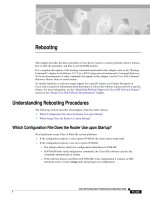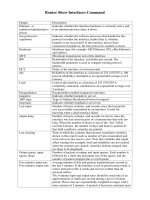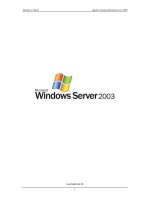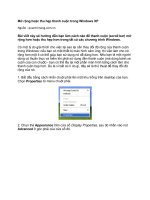Tài liệu mở rộng quản trị mạng IP Packet Header Fields
Bạn đang xem bản rút gọn của tài liệu. Xem và tải ngay bản đầy đủ của tài liệu tại đây (91.6 KB, 11 trang )
IP Packet Structure
All IP packets are structured the same way - an IP header followed by a variable-length
data field.
A summary of the contents of the internet header follows:
Version: 4 bits
The Version field indicates the format of the internet header. This document
describes version 4.
IHL: 4 bits
Internet Header Length is the length of the internet header in 32 bit words, and
thus points to the beginning of the data. Note that the minimum value for a correct
header is 5.
Type of Service: 8 bits
The Type of Service provides an indication of the abstract parameters of the
quality of service desired. These parameters are to be used to guide the selection
of the actual service parameters when transmitting a datagram through a particular
network. Several networks offer service precedence, which somehow treats high
precedence traffic as more important than other traffic (generally by accepting
only traffic above a certain precedence at time of high load). The major choice is
a three way tradeoff between low-delay, high-reliability, and high-throughput.
Bits 0-2: Precedence.
Bit 3: 0 = Normal Delay, 1 = Low Delay.
Bit 4: 0 = Normal Throughput, 1 = High Throughput.
Bit 5: 0 = Normal Relibility, 1 = High Relibility.
Bit 6-7: Reserved for Future Use.
Precedence
111 - Network Control 011 - Flash
110 - Internetwork Control 010 - Immediate
101 - CRITIC/ECP 001 - Priority
100 - Flash Override 000 - Routine
The use of the Delay, Throughput, and Reliability indications may increase the
cost (in some sense) of the service. In many networks better performance for one
of these parameters is coupled with worse performance on another. Except for
very unusual cases at most two of these three indications should be set.
The type of service is used to specify the treatment of the datagram during its
transmission through the internet system. Example mappings of the internet type
of service to the actual service provided on networks such as AUTODIN II,
ARPANET, SATNET, and PRNET is given in "Service Mappings" [8].
The Network Control precedence designation is intended to be used within a
network only. The actual use and control of that designation is up to each
network. The Internetwork Control designation is intended for use by gateway
control originators only. If the actual use of these precedence designations is of
concern to a particular network, it is the responsibility of that network to control
the access to, and use of, those precedence designations.
Total Length: 16 bits
Total Length is the length of the datagram, measured in octets, including internet
header and data. This field allows the length of a datagram to be up to 65,535
octets. Such long datagrams are impractical for most hosts and networks. All
hosts must be prepared to accept datagrams of up to 576 octets (whether they
arrive whole or in fragments). It is recommended that hosts only send datagrams
larger than 576 octets if they have assurance that the destination is prepared to
accept the larger datagrams.
The number 576 is selected to allow a reasonable sized data block to be
transmitted in addition to the required header information. For example, this size
allows a data block of 512 octets plus 64 header octets to fit in a datagram. The
maximal internet header is 60 octets, and a typical internet header is 20 octets,
allowing a margin for headers of higher level protocols.
Identification: 16 bits
An identifying value assigned by the sender to aid in assembling the fragments of
a datagram.
Flags: 3 bits
Various Control Flags.
Bit 0: reserved, must be zero
Bit 1: (DF) 0 = May Fragment, 1 = Don't Fragment.
Bit 2: (MF) 0 = Last Fragment, 1 = More Fragments.
Fragment Offset: 13 bits
This field indicates where in the datagram this fragment belongs. The fragment
offset is measured in units of 8 octets (64 bits). The first fragment has offset zero.
Time to Live: 8 bits
This field indicates the maximum time the datagram is allowed to remain in the
internet system. If this field contains the value zero, then the datagram must be
destroyed. This field is modified in internet header processing. The time is
measured in units of seconds, but since every module that processes a datagram
must decrease the TTL by at least one even if it process the datagram in less than
a second, the TTL must be thought of only as an upper bound on the time a
datagram may exist. The intention is to cause undeliverable datagrams to be
discarded, and to bound the maximum datagram lifetime.
Protocol: 8 bits
This field indicates the next level protocol used in the data portion of the internet
datagram. The values for various protocols are specified in "Assigned Numbers"
[9].
Header Checksum: 16 bits
A checksum on the header only. Since some header fields change (e.g., time to
live), this is recomputed and verified at each point that the internet header is
processed.
The checksum algorithm is:
The checksum field is the 16 bit one's complement of the one's
complement sum of all 16 bit words in the header. For purposes of
computing the checksum, the value of the checksum field is zero.
This is a simple to compute checksum and experimental evidence indicates it is
adequate, but it is provisional and may be replaced by a CRC procedure,
depending on further experience.
Source Address: 32 bits
The source address. See section 3.2.
Destination Address: 32 bits
The destination address. See section 3.2.
Options: variable
The options may appear or not in datagrams. They must be implemented by all IP
modules (host and gateways). What is optional is their transmission in any
particular datagram, not their implementation.
In some environments the security option may be required in all datagrams.
The option field is variable in length. There may be zero or more options. There
are two cases for the format of an option:
Case 1: A single octet of option-type.
Case 2: An option-type octet, an option-length octet, and the actual option
data octets.
The option-length octet counts the option-type octet and the option-length octet as
well as the option-data octets.
The option-type octet is viewed as having 3 fields:
1 bit copied flag,
2 bits option class,
5 bits option number.
The copied flag indicates that this option is copied into all fragments on
fragmentation.
0 = not copied
1 = copied
The option classes are:
0 = control
1 = reserved for future use
2 = debugging and measurement
3 = reserved for future use
The following internet options are defined:
CLASS NUMBER LENGTH DESCRIPTION
0 0 -
End of Option list. This option occupies only 1
octet; it has no length octet.
0 1 -
No Operation. This option occupies only 1 octet;
it has no length octet.
0 2 11
Security. Used to carry Security,
Compartmentation, User Group (TCC), and
Handling Restriction Codes compatible with
DOD requirements.
0 3 var.
Loose Source Routing. Used to route the internet
datagram based on information supplied by the
source.
0 9 var.
Strict Source Routing. Used to route the internet
datagram based on information supplied by the
source.
0 7 var.
Record Route. Used to trace the route an internet
datagram takes.
0 8 4 Stream ID. Used to carry the stream identifier.
2 4 var. Internet Timestamp.
End of Option List
+--------+
|00000000|
+--------+
Type=0









